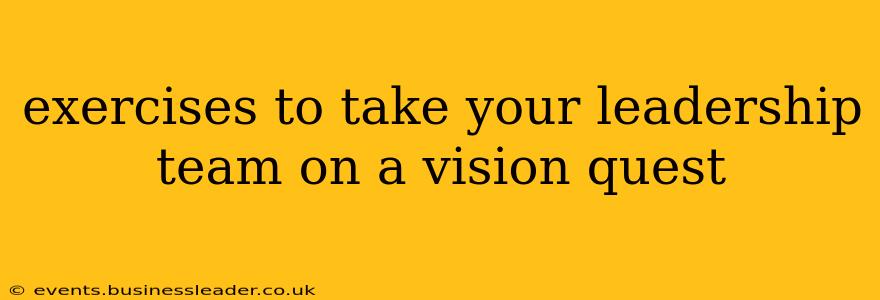Taking your leadership team on a vision quest isn't about literal wilderness trekking (though that could be a powerful component!). It's about a guided journey of introspection, collaboration, and strategic planning, leading to a shared, compelling vision for the future. This process fosters alignment, strengthens bonds, and empowers your team to confidently navigate challenges and seize opportunities.
This article will explore several exercises designed to ignite that vision, fostering a strong sense of shared purpose and direction within your leadership team. We'll delve into practical activities you can implement, regardless of your team's size or available resources.
What is a Leadership Vision Quest?
Before we dive into the exercises, it's crucial to understand the essence of a leadership vision quest. It's not just a brainstorming session; it's a carefully orchestrated experience aimed at:
- Clarifying individual and collective aspirations: Each leader gets a chance to reflect on their personal vision, aligning it with the broader organizational goals.
- Forging a shared vision: The quest culminates in a unified vision statement, a roadmap that guides future decisions and actions.
- Building team cohesion: The shared experience fosters trust, strengthens relationships, and encourages collaborative problem-solving.
- Enhancing strategic thinking: The process promotes creative thinking and strategic planning, equipping the leadership team to tackle complex challenges effectively.
Exercises to Ignite Your Leadership Vision Quest
Here are several impactful exercises to guide your leadership team on their vision quest:
1. Personal Vision Statements: Defining Individual Aspirations
The Exercise: Each leader individually writes a concise personal vision statement outlining their aspirations for the organization's future. This statement should articulate their individual contribution to the overall success. Encourage reflection on their values, passions, and long-term goals.
Why it Works: This foundational step ensures everyone has a clear understanding of their personal role within the bigger picture. It promotes self-awareness and sets the stage for collective alignment.
2. Future Scenario Planning: Exploring Potential Realities
The Exercise: Divide the team into smaller groups and assign them different potential future scenarios for the organization (e.g., rapid growth, market disruption, technological advancements). Each group develops a brief narrative describing their assigned scenario and the challenges and opportunities it presents.
Why it Works: This exercise fosters creative problem-solving and strategic thinking. It allows the team to anticipate potential challenges and develop proactive strategies to navigate uncertainty.
3. Ideal Future Workshop: Painting a Picture of Success
The Exercise: Guide the team through a workshop focused on visualizing the organization's ideal future. Use visual aids (whiteboards, mind maps) to capture their ideas. Encourage them to describe the organization's culture, market position, and impact in this ideal future.
Why it Works: This visual and collaborative approach allows for the creative expression of the team's collective aspirations, building a shared understanding of the desired future state.
4. "Strengths & Opportunities" Analysis: Leveraging Internal Capabilities
The Exercise: The team conducts a SWOT (Strengths, Weaknesses, Opportunities, Threats) analysis, focusing specifically on the organization's internal strengths and external opportunities. This allows them to identify areas of competitive advantage and leverage them in their vision.
Why it Works: This structured approach ensures that the vision is grounded in reality, aligning aspirations with the organization's capabilities and the external environment.
5. The "One-Word Vision" Challenge: Distilling the Essence
The Exercise: After brainstorming and discussing, challenge the team to summarize their collective vision into a single, powerful word. This word should encapsulate the essence of their aspirations.
Why it Works: This exercise forces concise and focused thinking, distilling the core message of the vision quest into its most potent form.
6. Developing the Vision Statement: Crafting a Shared Roadmap
The Exercise: Based on the previous exercises, the team collaboratively crafts a concise and compelling vision statement. This statement should be clear, concise, memorable, and inspiring.
Why it Works: This culminating exercise transforms individual and collective aspirations into a tangible roadmap, guiding the team's decisions and actions moving forward.
7. Action Planning: Translating Vision into Reality
The Exercise: The team develops a concise action plan outlining the key steps required to achieve their shared vision. This plan should include timelines, responsibilities, and measurable outcomes.
Why it Works: This ensures the vision quest isn't just an abstract exercise; it's a concrete plan with actionable steps to achieve the desired future.
By implementing these exercises, you'll guide your leadership team on a transformative journey, fostering a shared vision that empowers them to lead with confidence and purpose. Remember, the process is as important as the outcome. Encourage open communication, active listening, and mutual respect throughout the quest. This will cultivate a strong sense of unity and shared commitment to the future.
